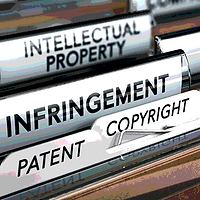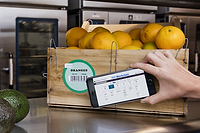Blockchain: Intersections with Food Safety and Intellectual Property

The food industry requires an efficient method to trace food products back to their source, especially in light of the recent Escherichia coli outbreaks. Last year, an untraceable E. coli outbreak caused hundreds of infections across 35 states, resulting in five fatalities.[1] Days after it initially announced the outbreak, the U.S. Centers for Disease Control and Prevention (CDC) announced that romaine lettuce from the Yuma, Arizona, region most likely caused the outbreak.[1] However, the CDC could not connect the outbreak to a specific farm or link in the supply chain.[2,3] More recently, hundreds of people across 10 states have been infected with E. coli—an outbreak that the CDC has tied to ground beef.[4] However, CDC has yet to identify a particular supplier as the source.[5]
One possible solution to the traceback problems that occurred in the E. coli outbreak is for companies to utilize blockchain technology throughout their supply chains, which some argue will provide better farm-to-table data.[6] To understand how blockchain technology could increase food safety, one must understand how the technology works.[7]
Blockchain consists primarily of three components working together to form a chain of blocks, which one can also describe as the unalterable history of a data set. First, there is a distributed ledger. This ledger tracks any updates blockchain users make to its contents. However, unlike a ledger at a bank, for example, it is not stored on a central server. Instead, it is distributed across a network of computers that each contain copies of the ledger. These computers are called nodes and are the second component. The third component is the block. A new block forms every time a user updates the ledger, and that new block is chained to the preceding block.
It is how these three components work together that makes blockchain such a unique technology. First, the entire system is encrypted and members can access it only if they provide their unique, private identification codes. Second, members cannot make any changes they want to the ledger. When a member accesses her version of the ledger, she will initiate a change that travels through the network to the other nodes for approval. The other nodes will approve the change only if it complies with the pre-established rules of that blockchain. If the change does not comply, the nodes reject it, and the ledger remains the same. If the change does comply, a new block forms with the updated ledger, which is then chained in chronological order to the preceding blocks. This allows members to see how this block is different from the previous block, when the change occurred, and who initiated the change.
Because changes require network-wide approval and private keys control access, many experts consider blockchain one of the safest methods of storing data and completing transactions. This security makes blockchain an important technology for improving supply chain traceability. And, while blockchain use has been most notably popularized by the Bitcoin cryptocurrency, technology experts predict many industries will find ways to utilize blockchain to their advantage.
Recent Developments of Blockchain in the Food Safety Space
Within the last year, more companies have implemented blockchain technology to promote food safety and transparency. Walmart in particular has taken notable strides toward implementing this technology through its partnership with IBM.[8] Prior to using blockchain technology, Frank Yiannis, Walmart’s then-vice president of food safety, asked his team to trace a shipment of mangoes back to its source. To do so, the team manually reviewed paperwork from multiple farms, packinghouses, brokers, import warehouses, and a processing facility, which was very similar in size to the Yuma region romaine lettuce supply chain. It took the team 6 days, 18 hours, and 26 minutes to accomplish the trace. Then, Walmart used blockchain software along the same supply chain for 30 days, building up the route’s data set. When Yiannis’s team traced back the next shipment of mangoes, it took 2.2 seconds to find exactly where that shipment of mangoes originated. Today, the company traces more than 25 products using blockchain technology, including mangoes, meat, and baby food.[9] In September 2018, Walmart announced that it would begin using blockchain technology to track every bag of spinach and lettuce back to its source.[10] In a letter to its leafy green suppliers, Walmart stated that these suppliers will be required to “enable end-to-end traceability back to farm” by September 30, 2019.[11]
Walmart and many other multinational food companies interested in promoting food safety (including Albertsons Companies, Dole Food Co., Kroger, Nestlé, Tyson Foods, and Unilever)[12–14] have implemented blockchain programs in connection with the IBM Food Trust network.[9] IBM is one of the leaders in the development of blockchain technology in the food safety space.[15] In October 2018, the technology company launched the Food Trust network to provide retailers the opportunity to use its commercial blockchain technology to track food products throughout the supply chain.[13]
The Changing Shape of the Patent Landscape
In addition to the heightened use of blockchain technology in the food safety space, the number of issued patents involving blockchain technology has increased greatly within the last year. Since June 2018, over 200 patents including the claim term “blockchain” or “distributed ledger” have issued, which accounts for approximately 80 percent of the total issued patents containing these claim terms.[16] Unsurprisingly, approximately 10 percent of these patents are assigned to IBM. With its Food Trust network, IBM has become an important player in the blockchain and food safety space, and companies wishing to employ blockchain technology in this space should consider potential licensing opportunities and the methods IBM is utilizing to enforce its blockchain patents.[17]
The 2019 Revised Patent Subject Matter Eligibility Guidance[18] is having a positive effect on the patentability of blockchain technologies. These guidelines, which took effect on January 7, 2019, clarify the judicial exception for abstract ideas—an exception examiners commonly used to reject software patents under 35 U.S.C. 101 before the revised guidance was issued.[19] Through the revised guidelines, the U.S. Patent and Trademark Office (USPTO) created three main categories for abstract ideas: mathematical concepts, certain methods of organizing human activity, and mental processes.[18] If the claimed subject matter does not fall into one of these categories, it is not an abstract idea and thus is patent-eligible. Further, the USPTO stated that the claim must be “directed to” the judicial exception for the exception to apply. A claim is not “directed to” a judicial exception, and is thus eligible subject matter, if the claim integrates the exception “into a practical application of the exception.” These guidelines have positive implications for the subject-matter eligibility of blockchain technologies because examiners now have a more constricted standard for determining what constitutes an abstract idea.[20] Approximately 60 percent of the blockchain patents issued since June 2018 were issued after the revised guidelines took effect.[16] While this does not present a clear trend, these revised guidelines provide applicants with more predictability as they draft their blockchain patent applications and may lead to fewer subject-matter rejections.[18]
Although these revised guidelines might reduce the amount of 101 rejections (rejections on the basis of subject-matter eligibility), companies wishing to patent blockchain technologies must still overcome 102 and 103 rejections (rejections for being non-novel or an obvious improvement of an existing invention) and show that their inventions are novel and non-obvious even in light of the many prior blockchain technologies. In many of the recently issued patents, companies have innovated by improving blockchain’s data security and protection.[21,22] For example, in one of its recent blockchain patents, IBM focused on preventing fraud when users enter information to track a particular asset.[23]
Conclusions
An increasing number of food companies are implementing blockchain technology to improve food product traceability and food safety. This technology will allow companies to more efficiently identify the source of outbreaks stemming from contaminated food products and provide concerned consumers with the information they demand about the source of their food. As more entities are securing issued patents involving blockchain technology, it is important for food companies wishing to invoke this technology to consider licensing opportunities and potential enforcement.
Bridget Hayden, Esq., is a partner at Dorsey & Whitney LLP, where she is chair of the Food, Beverage, and Agribusiness industry group and a member of the patent group. With over 15 years of experience, she works closely with clients to identify, evaluate, cultivate, and secure protection for their innovations and grows intellectual property assets through effective portfolio management. Madison Murhammer is a law student at the University of Iowa and also holds a B.Sc. in chemical engineering from the University of Iowa.
References
1. www.cdc.gov/ecoli/2018/o157h7-04-18/index.html.
2. www.kawc.org/post/5-dead-197-ill-e-coli-romaine-lettuce-grown-yuma-region-fda-still-investigating.
3. www.minncle.org/eAccess/1023311901/IP_Book_2018.pdf.
4. www.cdc.gov/ecoli/2019/o103-04-19/index.html.
5. www.cidrap.umn.edu/news-perspective/2019/04/cdc-ties-ground-beef-e-coli-outbreak-source-still-unknown.
6. www.ibm.com/blogs/blockchain/2017/06/the-food-industry-gets-an-upgrade-with-blockchain/.
7. medium.com/@micheledaliessi/how-does-the-blockchain-work-98c8cd01d2ae.
8. newfoodeconomy.org/blockchain-food-traceability-walmart-ibm/.
9. www.hyperledger.org/resources/publications/walmart-case-study.
10. www.nytimes.com/2018/09/24/business/walmart-blockchain-lettuce.html.
11. corporate.walmart.com/media-library/document/blockchain-supplier-letter-september-2018/_proxyDocument?id=00000166-088d-dc77-a7ff-4dff689f0001.
12. www.marketwatch.com/press-release/albertsons-companies-to-join-blockchain-based-ibm-food-trust-network-to-pilot-increased-transparency-for-romaine-lettuce-2019-04-11/.
13. www.forbes.com/sites/astanley/2018/10/08/ready-to-rumble-ibm-launches-food-trust-blockchain-for-commercial-use/#27796edd7439.
14. moneymorning.com/2019/05/28/i-just-saw-the-future-of-cryptocurrency-what-you-need-to-know-now/.
15. cointelegraph.com/news/ibms-blockchain-patents-from-food-tracking-and-shipping-to-iot-and-security-solutions.
16. patft.uspto.gov/netahtml/PTO/search-adv.htm.
17. www.ibm.com/blockchain/solutions.
18. 2019 Revised Patent Subject Matter Eligibility Guidance, 84 Fed. Reg. 50 (Jan. 7, 2019).
19. www.americanbar.org/groups/intellectual_property_law/publications/landslide/2017-18/march-april/patentability-blockchain-technology-future-innovation/.
20. U.S. Patent No. 10,291,413 (filed May 15, 2017, issued May, 14, 2019).
21. U.S. Patent No. 10,305,875 (filed Jan. 28, 2019, issued May 28, 2019).
22. U.S. Patent No. 10,298,585 (filed Jan. 23, 2019, issued May 21, 2019).
23. U.S. Patent No. 10,275,739 (filed Jan. 5, 2017, issued Apr. 30, 2019).
Looking for a reprint of this article?
From high-res PDFs to custom plaques, order your copy today!








